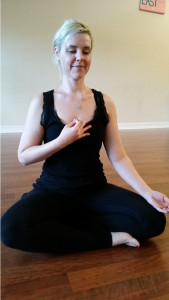The sankalpa New Year’s resolution
By Nancy B. Loughlin
Published in News Press on January 27, 2015
How are those resolutions working out for you?
You wanted to lose the standard 20, exercise more, smoke and drink less, snag a romantic partner or stick with that bookclub. Would all of this make you happy? Really?
These aren’t bad resolutions. But, you might raise your expectations.
“When you are making a resolution, you are assuming that what you are isn’t enough to have a happy life,” said April Puciata, Washington, D.C. yoga teacher and practitioner of the Sankalpa tradition. She recently appeared at Joyful Yoga, Bonita Springs.
The real problem might be that your life isn’t in alignment with your true nature and your dharma. Your Sankalpa is your determination to live up to your highest Self, and that is a bigger resolution than working out. There is a deeper hunger you must satisfy.
According to Puciata, Sankalpa is an intention that resonates with your spirit helping you to live your highest truth. Sankalpa comes from two words. “San” means resonates with spirit, and “Kalpa” means intention, she said.
“There is nothing wrong with New Year’s resolutions. However, when we make resolutions, we count on the will power of the conscious mind to carry them out. This is difficult because the unconscious governs so much of what we do,” Puciata said.
In the Sankalpa meditation you align the mind with the highest self and plant that truth into the unconscious,” she said.
A complete Sankalpa practice requires rigorous study and application of asana (yoga postures), pranayama (breathwork), mudras (hand gestures), mantras (chants) and visualization. Puciata suggests that beginners start with this basic Sankalpa meditation:
- Soham loosely means “I am that.” Use this mantra to cleanse the energy and begin focusing the mind.
During yoga practice, rounds of sun salutations, cycling, running or cleaning the house, match the breath to the sounds of soham. On the inhale, visualize a ray of light from your crown shooting down the spine to the sound of “so.” On the exhale, imagine that light emerging from the base of your sacrum and spreading through the body to the sound of “ham.”
The Soham down the spine is to help get in touch with that subtle line of energy and bring inspiration into your everyday living. Puciata recommends making soham your default mantra when stressed, waiting in traffic or in line or during morning meditation.
2. Begin alternate-nostril breathing to balance the right and left sides of the brain.
While seated on the floor or in a straight chair, place your index and middle fingers of your right hand on your third eye in the middle of your forehead. Your ring finger and pinky are over your left nostril and your thumb over your right. Close off the left side of your nose and breathe in only through the right. Then, close the nose completely, and hold the breath. Then, release only through the left side of the nose. Inhale left. Hold. Exhale right.
Repeat for 6-12 rounds. Your mind may wander, but gently and without judgment, bring yourself back.
3. After alternate-nostril breathing allow the hands to rest on your knees and visualize a ball of light at the base of your spine. On the inhale, the ball of light traces the curves of the spine up to the midbrain. On the exhale the ball traces the curves back down to the base of the spine. On the inhale use the mantra “ham.” On the exhale, “so.” If you find the mind pulling you away, stay with the mantra.
If your mind is quiet, allow your awareness to rest on your third-eye center.
Be still, and listen to yourSelf. YourSelf will speak when you are ready, and you’ll know what you really want. Really.
For more information, visit www.AprilYoga.com.

